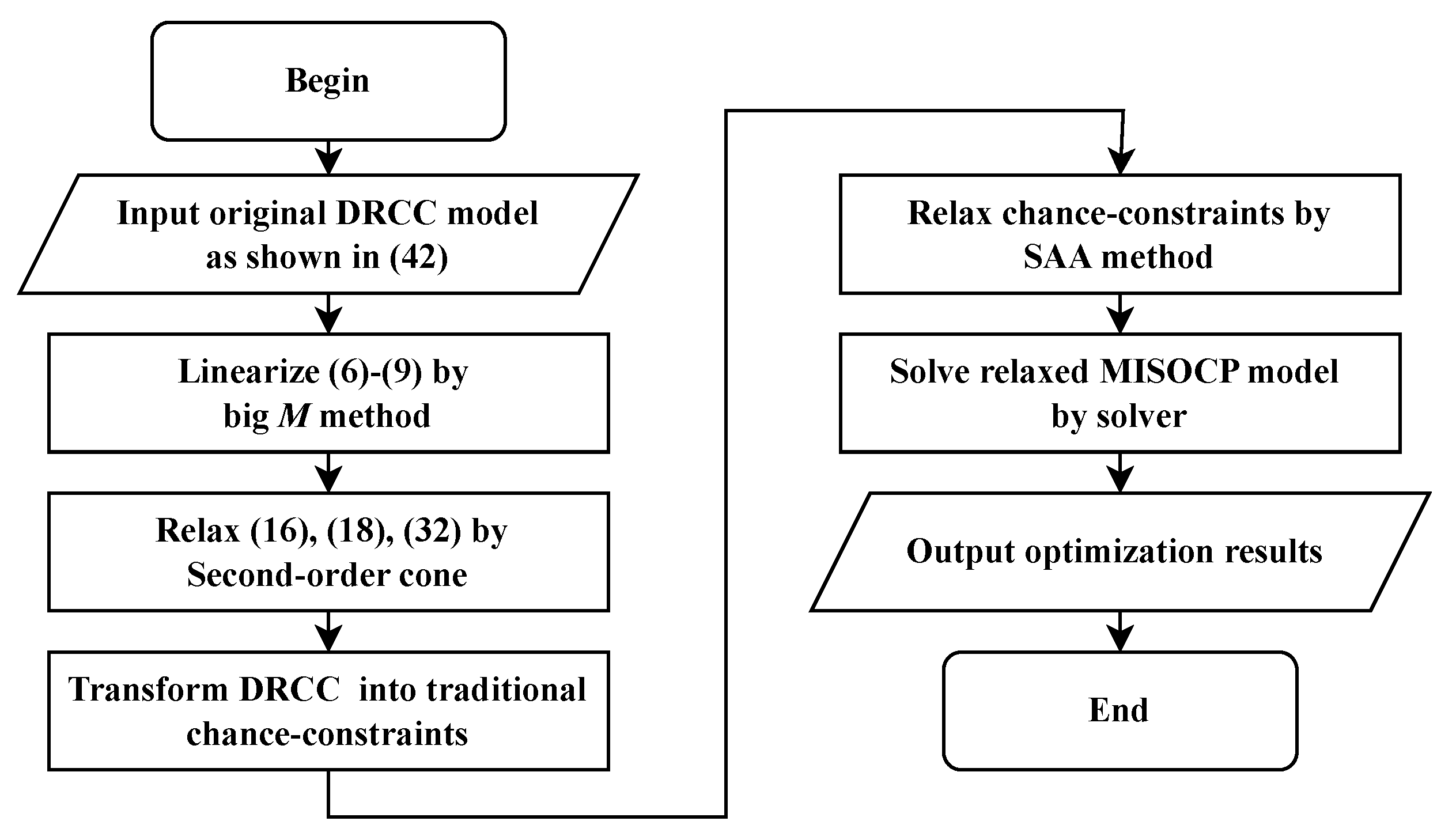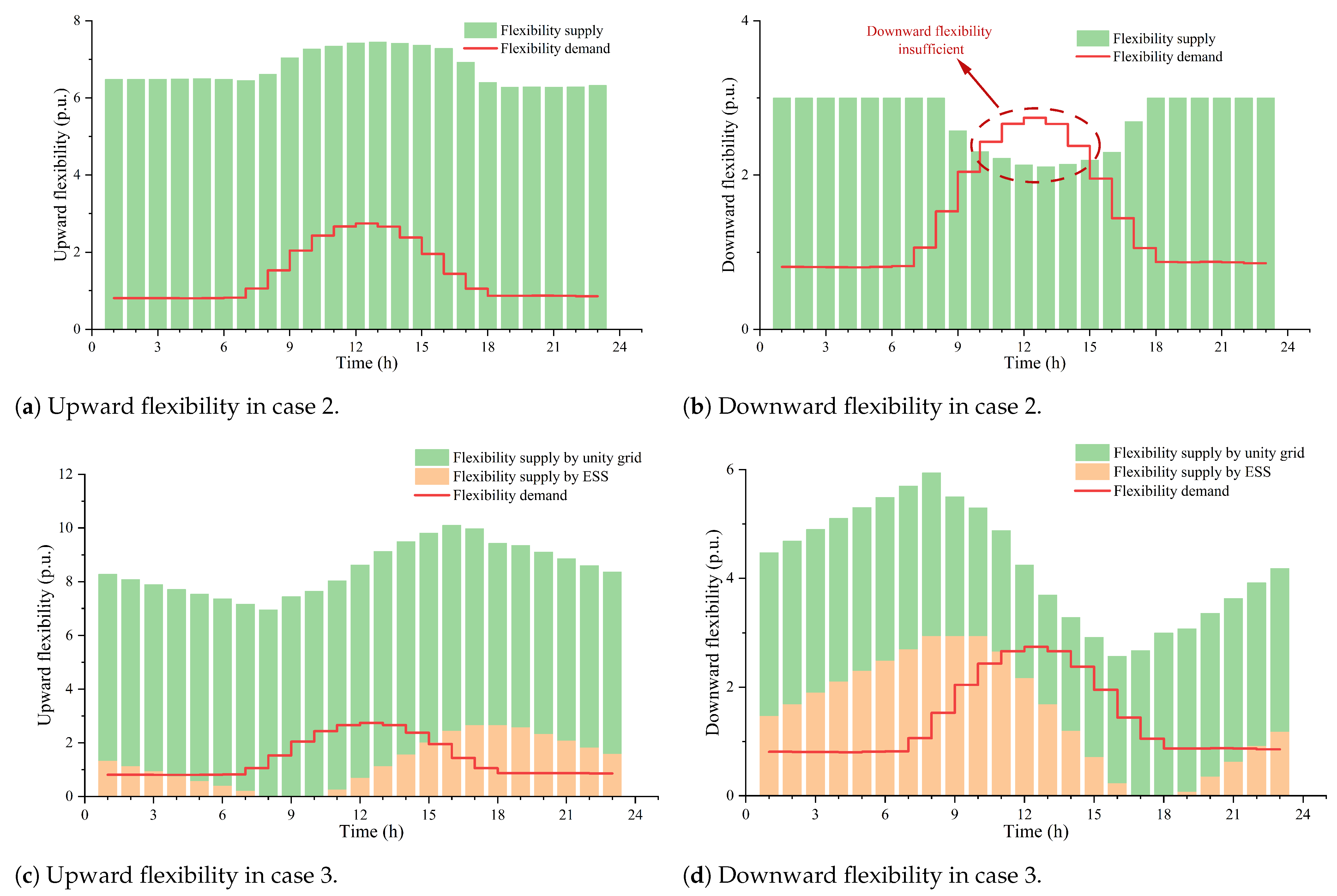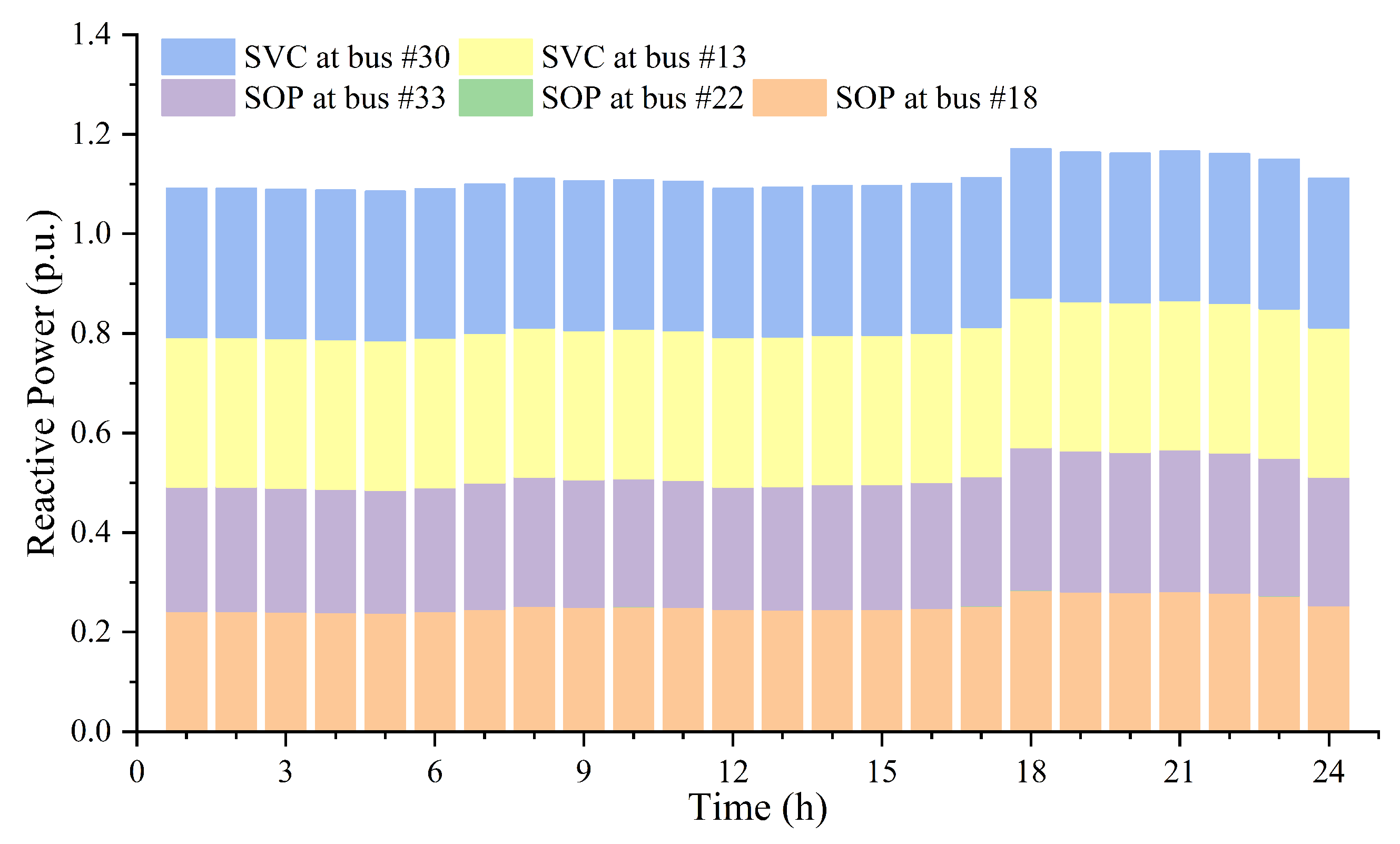Flexibility-Oriented AC/DC Hybrid Grid Optimization Using Distributionally Robust Chance-Constrained Method
Abstract
1. Introduction
- We propose a framework for enhancing operational flexibility in AC/DC hybrid distribution networks. Comprehensive evaluation indexes for operational flexibility assessment are also established, which include the flexibility balance index, bus flexibility index, and branch flexibility index.
- We develop a flexibility-oriented DRCC model for AC/DC hybrid distribution networks operation, which effectively manages the stochastic fluctuations of source and load during the day-ahead scheduling. A customized solution method based on second-order cone relaxation and sample average approximation (SAA) is also proposed.
2. Framework for Enhancing Flexibility of AC/DC Hybrid Distribution Network
2.1. Flexibility Enhancement Methods
- Sharing ESS among multiple feeders. As an energy component, ESS can temporarily enhance the distribution network’s flexibility. However, ESS connected to a single fixed node faces challenges adjusting to excess renewable energy and insufficient power supply on other feeders. On the other hand, as a power component, SOP can spatially enhance the distribution network’s flexibility but lacks energy storage capability and relies on the energy supply from the connected feeder lines. Therefore, ESS and SOP enhance the flexibility in the dimensions of time and space, respectively, and the advantages of these two components complement each other. In the AC/DC hybrid distribution network, the centralized ESS located at the DC part is connected to multiple feeders of the AC network through the SOP converter, realizing the adaptive sharing of ESS resources across multiple feeders. By adjusting the charging and discharging power of ESS at different times, the problem of temporal and spatial mismatch between the source and load can be effectively solved.
- Reactive power adaptive compensation. To address voltage issues at feeder-end buses, reactive power compensation is adopted, and the static var compensator (SVC) and SOP play vital roles in this regard. The SVC can adjust the reactive power locally, thereby improving voltage stability and ensuring power quality for high-end users. Meanwhile, the SOP can also inject reactive power into AC buses (see SOP’s operation model in Section 3.1.2), balancing the voltage across multiple feeders. Together, SVC and SOP provide a coordinated approach to maintaining voltage levels, enhancing the nodal flexibility of the distribution network.
- Power transfer among feeders. Uneven load distribution among feeders can lead to overloading issues on specific lines. The SOP’s power transfer capability addresses this by redistributing active power among feeders. In an AC/DC hybrid distribution network, the SOP facilitates power transfer between heavily loaded and lightly loaded feeders, as well as AC and DC parts, thereby balancing the load and preventing potential overloads. This power transfer capability enhances the spatial flexibility of the network, ensuring that no single feeder becomes a bottleneck and improves the branch efficiency of the distribution network.
2.2. Flexibility Evaluation Indexes
2.2.1. Flexibility Balance Index
2.2.2. Bus Flexibility Index
2.2.3. Branch Flexibility Index
3. DRCC Model for AC/DC Hybrid Network Operation
3.1. Deterministic Optimization Model
3.1.1. Objective Function
3.1.2. SOP Operation Constraints
3.1.3. ESS Operation Constraints
3.1.4. Unified Hybrid AC/DC Power Flow Constraint
3.1.5. Feasible Constraints of Decision Variables
3.2. Kullback–Leibler Divergence Ambiguity Set for Scenario Probabilities
3.3. DRCC Optimization Model
4. Solution Method
5. Case Study
5.1. Case Settings
5.2. Results and Analysis
5.2.1. Flexibility of Supply-Demand Balance
5.2.2. Bus Flexibility
5.2.3. Branch Flexibility
6. Conclusions
Author Contributions
Funding
Data Availability Statement
Acknowledgments
Conflicts of Interest
Abbreviations and Nomenclature
| Abbreviations | |
| DRCC | Distributionally robust chance-constrained |
| DG | Distributed generator |
| PV | Photovoltaic |
| SOP | Soft open point |
| ESS | Energy storage system |
| SAA | Sample average approximation |
| MISOCP | Mixed integer second-order cone programming |
| Sets and Indices | |
| , | Sets of all the buses in the AC and DC part of the network |
| , | Sets of lines in the AC and DC part of the network |
| Set of scenarios | |
| s | Index of scenarios |
| t | Index of time |
| Parameters | |
| T | Total number of time slots in a scheduling day |
| Time interval | |
| Net-load of the distribution network | |
| Load demand of bus i | |
| DG output of bus i | |
| Maximum power from utility grid at AC bus i | |
| , | Upward and downward ramping ratios of utility grid |
| , | Power and capacity of the ESS at DC bus j |
| , | Minimum and maximum SOC of ESSs |
| , | Efficiency of ESSs and SOPs |
| Capacity of SOP converter at bus j | |
| Reactive power limitation coefficient of SOPs | |
| Upper limit of the current amplitude on line | |
| , | Lower and upper limit of voltage magnitude |
| , | Resistance and reactance of branch |
| Maximum reactive power that an SVC can release or absorb | |
| Variables | |
| Upward flexibility demand | |
| Downward flexibility demand | |
| Upward flexibility supply | |
| Downward flexibility supply | |
| , | Upward and downward flexibility supply by utility grid |
| , | Upward and downward flexibility supply by ESS |
| Probability of the scenario | |
| Active power supplied by the utility grid | |
| , | Charge and discharge power of the ESS |
| , | Binary variables indicating whether ESS is charging (discharging) or not; |
| () if ESS is charging (discharging) | |
| State of charge of the ESS | |
| , | Active and reactive power of the SOP converter injected into the AC network |
| at bus j | |
| Active power loss of the SOP converter | |
| , | Shut power of DG and load |
| Line loss on branch | |
| Square of the voltage amplitude on bus i | |
| Square of the current amplitude on line | |
| , | Active and reactive power flowing from bus i to k on branch |
References
- Hassan, S.J.U.; Mehdi, A.; Haider, Z.; Song, J.S.; Abraham, A.D.; Shin, G.S.; Kim, C.H. Towards medium voltage hybrid AC/DC distribution Systems: Architectural Topologies, planning and operation. Int. J. Electr. Power Energy Syst. 2024, 159, 110003. [Google Scholar] [CrossRef]
- Charadi, S.; Chaibi, Y.; Redouane, A.; Allouhi, A.; El Hasnaoui, A.; Mahmoudi, H. Efficiency and energy-loss analysis for hybrid AC/DC distribution systems and microgrids: A review. Int. Trans. Electr. Energy Syst. 2021, 31, e13203. [Google Scholar] [CrossRef]
- Javid, Z.; Kocar, I.; Holderbaum, W.; Karaagac, U. Future distribution networks: A review. Energies 2024, 17, 1822. [Google Scholar] [CrossRef]
- Li, S.; Li, Z.; Shahidehpour, M.; Huang, W.; Zheng, J.H. Dispatchable region for distributed renewable energy generation in reconfigurable AC-DC distribution networks with soft open points. Appl. Energy 2024, 371, 123704. [Google Scholar] [CrossRef]
- Qi, C.; Wang, K.; Fu, Y.; Li, G.; Han, B.; Huang, R.; Pu, T. A decentralized optimal operation of AC/DC hybrid distribution grids. IEEE Trans. Smart Grid 2018, 9, 6095–6105. [Google Scholar] [CrossRef]
- Peng, Q.; Qu, L.; Yuan, Z.; Wang, X.; Chen, Y.; Tian, B. Optimal scheduling strategy of AC/DC hybrid distribution network based on power electronic transformer. Energies 2021, 14, 3219. [Google Scholar] [CrossRef]
- Qian, T.; Ming, W.; Shao, C.; Hu, Q.; Wang, X.; Wu, J.; Wu, Z. An edge intelligence-based framework for online scheduling of soft open points with energy storage. IEEE Trans. Smart Grid 2024, 15, 2934–2945. [Google Scholar] [CrossRef]
- Gholami, K.; Azizivahed, A.; Arefi, A.; Rahman, M.M.; Islam, M.R.; Li, L.; Arif, M.T.; Haque, M.E. Hybrid uncertainty approach for management of energy storage-embedded soft open points in distribution grids. J. Energy Storage 2024, 87, 111394. [Google Scholar] [CrossRef]
- Chen, L.; Zhang, N.; Yang, X.; Pei, W.; Zhao, Z.; Zhu, Y.; Xiao, H. Synergetic optimization operation method for distribution network based on SOP and PV. Glob. Energy Interconnect. 2024, 7, 130–141. [Google Scholar] [CrossRef]
- Li, J.; Ge, S.; Zhang, S.; Xu, Z.; Wang, L.; Wang, C.; Liu, H. A multi-objective stochastic-information gap decision model for soft open points planning considering power fluctuation and growth uncertainty. Appl. Energy 2022, 317, 119141. [Google Scholar] [CrossRef]
- Esmail, E.M.; Elkalashy, N.I.; Kawady, T.A.; Taalab, A.M.; Elsadd, M.A. Modified autonomous fault management strategy for enhancing distribution network reliability. Electr. Eng. 2022, 104, 233–248. [Google Scholar] [CrossRef]
- Pan, H.; Ding, M.; Chen, A.; Bi, R.; Sun, L.; Shi, S. Research on distributed power capacity and site optimization planning of AC/DC hybrid micrograms considering line factors. Energies 2018, 11, 1930. [Google Scholar] [CrossRef]
- Ghadiri, A.; Haghifam, M.R.; Larimi, S.M.M. Comprehensive approach for hybrid AC/DC distribution network planning using genetic algorithm. IET Gener. Transm. Distrib. 2017, 11, 3892–3902. [Google Scholar] [CrossRef]
- Elkholy, M.H.; Yona, A.; Ueda, S.; Said, T.; Senjyu, T.; Lotfy, M.E. Experimental Investigation of AI-Enhanced FPGA-Based Optimal Management and Control of an Isolated Microgrid. IEEE Trans. Transp. Electrif. 2024, 10, 3670–3679. [Google Scholar] [CrossRef]
- Zhao, W.; Zheng, J.; Han, Z.; Liu, H. Large-disturbance stability analysis method based on mixed potential function for AC/DC hybrid distribution network with PET. IET Gener. Transm. Distrib. 2020, 14, 3802–3813. [Google Scholar] [CrossRef]
- Zhang, L.; Chen, Y.; Shen, C.; Tang, W.; Liang, J.; Xu, B. Optimal configuration of hybrid AC/DC urban distribution networks for high penetration renewable energy. IET Gener. Transm. Distrib. 2018, 12, 4499–4506. [Google Scholar] [CrossRef]
- Meng, W.; Song, D.; Huang, L.; Chen, X.; Yang, J.; Dong, M.; Talaat, M.; Elkholy, M.H. Distributed energy management of electric vehicle charging stations based on hierarchical pricing mechanism and aggregate feasible regions. Energy 2024, 291, 130332. [Google Scholar] [CrossRef]
- Zhao, J.; Qu, J.; Ji, H.; Xu, J.; Hasanien, H.M.; Turky, R.A.; Li, P. Robust operation of flexible distribution network with large-scale EV charging loads. IEEE Trans. Transp. Electrif. 2024, 10, 2207–2219. [Google Scholar] [CrossRef]
- Liu, J.; Weng, X.; Bao, M.; Lu, S.; He, C. Active distribution network expansion planning based on Wasserstein distance and dual relaxation. Energies 2024, 17, 3005. [Google Scholar] [CrossRef]
- Zare, A.; Chung, C.Y.; Zhan, J.; Faried, S.O. A distributionally robust chance-constrained MILP model for multistage distribution system planning with uncertain renewables and loads. IEEE Trans. Power Syst. 2018, 33, 5248–5262. [Google Scholar] [CrossRef]
- Babaei, S.; Jiang, R.; Zhao, C. Distributionally Robust Distribution Network Configuration Under Random Contingency. IEEE Trans. Power Syst. 2020, 35, 3332–3341. [Google Scholar] [CrossRef]
- Gao, H.; Li, Y.; He, S.; Tang, Z.; Liu, J. Distributionally robust planning for power distribution network considering multi-energy station enabled integrated demand response. Energy 2024, 306, 132460. [Google Scholar] [CrossRef]
- Han, J.P.; Liu, N.; Catalao, J.P.S. Optimization of distribution network and mobile network with interactive balance of flexibility and power. IEEE Trans. Power Syst. 2023, 38, 2512–2524. [Google Scholar] [CrossRef]
- Wu, X.; Wang, Z.; Ding, T.; Li, Z. Hybrid AC/DC microgrid planning with optimal placement of DC feeders. Energies 2019, 12, 1751. [Google Scholar] [CrossRef]
- Chen, Y.; Guo, Q.; Sun, H.; Li, Z.; Wu, W.; Li, Z. A distributionally robust optimization model for unit commitment based on Kullback-Leibler divergence. IEEE Trans. Power Syst. 2018, 33, 5147–5160. [Google Scholar] [CrossRef]
- Jiang, R.; Guan, Y. Data-driven chance constrained stochastic program. Math. Program. 2016, 158, 291–327. [Google Scholar] [CrossRef]
- Yang, L.; Cao, Y.; Wei, W.; Chen, L.; Mei, S. Configuration method of energy storage for wind farms considering wind power uncertainty and wind curtailment constraint. Autom. Electr. Power Syst. 2020, 44, 45–52. [Google Scholar]
- Baran, M.; Wu, F. Network reconfiguration in distribution-systems for loss reduction and load balancing. IEEE Trans. Power Deliv. 1989, 4, 1401–1407. [Google Scholar] [CrossRef]
- Zhuo, Z.; Zhang, N.; Yang, J.; Kang, C.; Smith, C.; O’Malley, M.J.; Kroposki, B. Transmission expansion planning test system for AC/DC Hybrid grid with high variable renewable energy penetration. IEEE Trans. Power Syst. 2020, 35, 2597–2608. [Google Scholar] [CrossRef]








| Device | Location | Capacity/Resistance |
|---|---|---|
| Utility grid transformer 1 | #1 | 10 MW |
| AC PV | #8 | MW |
| SVCs | #13, #30 | ∼, ∼ |
| DC PVs | #34, #36 | MW, 1 MW |
| ESS 2 | #40 | 2 MW/4 MWh |
| SOPs 3 | #18, #22, #33 | 1 MW, 1 MW, 1 MW |
| DC loads | #35, #37, #38, #39, #41 | 30 kW, 20 kW, 60 kW, 40 kW, 20 kW |
| DC branches | #34–#35, #35–#41, #36–#37, #37–#38, #38–#39, #39–#40, #40–#41 | , , , , , , , |
| Case No. | ||||
|---|---|---|---|---|
| case 1 | 7.126 | |||
| case 2 | 6.424 | |||
| case 3 | 9.539 |
Disclaimer/Publisher’s Note: The statements, opinions and data contained in all publications are solely those of the individual author(s) and contributor(s) and not of MDPI and/or the editor(s). MDPI and/or the editor(s) disclaim responsibility for any injury to people or property resulting from any ideas, methods, instructions or products referred to in the content. |
© 2024 by the authors. Licensee MDPI, Basel, Switzerland. This article is an open access article distributed under the terms and conditions of the Creative Commons Attribution (CC BY) license (https://creativecommons.org/licenses/by/4.0/).
Share and Cite
Chen, Y.; Lu, Q.; Zeng, K.; Yang, Y.; Xie, P. Flexibility-Oriented AC/DC Hybrid Grid Optimization Using Distributionally Robust Chance-Constrained Method. Energies 2024, 17, 4902. https://doi.org/10.3390/en17194902
Chen Y, Lu Q, Zeng K, Yang Y, Xie P. Flexibility-Oriented AC/DC Hybrid Grid Optimization Using Distributionally Robust Chance-Constrained Method. Energies. 2024; 17(19):4902. https://doi.org/10.3390/en17194902
Chicago/Turabian StyleChen, Yue, Qiuyu Lu, Kaiyue Zeng, Yinguo Yang, and Pingping Xie. 2024. "Flexibility-Oriented AC/DC Hybrid Grid Optimization Using Distributionally Robust Chance-Constrained Method" Energies 17, no. 19: 4902. https://doi.org/10.3390/en17194902
APA StyleChen, Y., Lu, Q., Zeng, K., Yang, Y., & Xie, P. (2024). Flexibility-Oriented AC/DC Hybrid Grid Optimization Using Distributionally Robust Chance-Constrained Method. Energies, 17(19), 4902. https://doi.org/10.3390/en17194902





